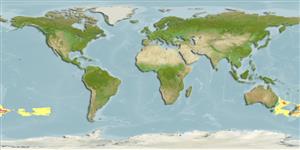Классификация / Names
народные названия | синонимы | Catalog of Fishes(род, виды) | ITIS | CoL | WoRMS | Cloffa
>
Scombriformes (Mackerels) >
Chiasmodontidae (Snaketooth fishes)
Etymology: Pseudoscopelus: Greek, pseudes = false + Greek, skopelos = a lantern fish (Ref. 45335). Lütken did not recognize the presence of photophores on the body, confusing them with pores, but referred to a genus of lanternfish (Scopelus now Myctophum) when he named the genus (Ref. 85782); paxtoni: Named for John Paxton, in recognition of his contributions to the knowledge of the deep-sea ichthyofauna, and all the support given to the development of this work.
Eponymy: Dr John Richard Paxton (d: 1938) is an American-born Australian ichthyologist. [...] (Ref. 128868), visit book page.
Issue
This species is synonym ofPseudoscopelus altipinnis Parr, 1933 in Eschmeyer (CofF ver. Jan. 2012: Ref. 89336) following (Prokofiev, 2011). Waiting for the publication.
Environment: milieu / climate zone / depth range / distribution range
экология
морской батипелагический; пределы глубины 893 - 1223 m (Ref. 85782). Deep-water
Southwest Pacific: Chatham Islands to west of New Zealand; from 173° W to 167° E, 39° to 48° S.
Size / Вес / Возраст
Maturity: Lm ? range ? - ? cm
Max length : 22.8 cm SL самец/пол неопределен; (Ref. 85782)
Краткое описание
определительные ключи | морфология | морфометрия
колючие лучи спинного плавника (общее число) : 22 - 24; членистые (мягкие) лучи анального плавника: 21 - 23; позвонки: 36 - 38. This species of the Pseudoscopelus altipinnis species group is distinct from P. altipinnis by dentition and photophore pattern: innermost teeth of mesial rows of premaxilla and dentary elongate, when mouth is closed and premaxilla is retracted reach the medial border of the contralateral premaxilla (vs. not extremely elongated and premaxilla is retracted teeth do not reach the medial border of premaxilla of the other side); teeth of mesial row of premaxilla and internal most row of dentary straight (vs. teeth of mesial row of premaxilla and internal-most row of dentary slightly curved); mesial series of premaxillary teeth arranged in transverse rows of one to three rows of teeth (vs. mesial series of premaxillary teeth arranged in transverse rows of one to five rows of teeth) (Ref. 85782).
Meso- to bathypelagic, from 893 to 1223 m (mean 1027 m) (Ref. 85782).
Life cycle and mating behavior
половая зрелость | размножение | нерест | икра | Fecundity | личинки
Melo, M.R.S., 2010. A revision of the genus Pseudoscopelus Lütken (Chiasmodontidae: Acanthomorphata) with descriptions of three new species. Zootaxa 2710:1-78. (Ref. 85782)
Статус Красного Списка МСОП (Ref. 130435: Version 2024-1)
Угроза для людей
Harmless
Использование человеком
дополнительная информация
инструменты
Специальные отчеты
Скачать в формате XML
ресурсы в Интернет
Estimates based on models
Preferred temperature (Ref.
123201): 3.9 - 5.4, mean 4.1 °C (based on 6 cells).
Phylogenetic diversity index (Ref.
82804): PD
50 = 0.5000 [Uniqueness, from 0.5 = low to 2.0 = high].
Bayesian length-weight: a=0.00389 (0.00180 - 0.00842), b=3.12 (2.94 - 3.30), in cm total length, based on all LWR estimates for this body shape (Ref.
93245).
Trophic level (Ref.
69278): 3.8 ±0.2 se; based on size and trophs of closest relatives
Fishing Vulnerability (Ref.
59153): Low vulnerability (18 of 100).
